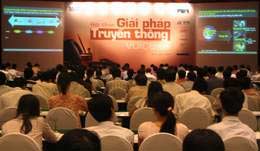On July 13, to mark its 7th anniversary in the Internet Protocol (IP) communications market, Cisco held the VoiceComm 2006 Solutions Workshop.
 The VoiceComm 2006 Workshop lasted for one day and was designed for IT professionals to explore the latest technologies in IP communications and the value that Cisco’s Unified Communications solutions can bring to businesses.
The VoiceComm 2006 Workshop lasted for one day and was designed for IT professionals to explore the latest technologies in IP communications and the value that Cisco’s Unified Communications solutions can bring to businesses.
This workshop was sponsored by the Ministry of Information and Communications of Vietnam, alongside participation from many domestic and international partners.
During the VoiceComm 2006 workshop, Cisco also officially introduced its Unified Communications System—recently announced worldwide in March. This system integrates voice and video communication products and applications to help businesses operate more efficiently, streamline business processes, access the right resources on the first attempt, and enhance performance and operational efficiency.
Featuring multiple specialized discussion sessions accompanied by partner exhibitions showcasing IP communication solutions, the Cisco VoiceComm 2006 Workshop provided a comprehensive “all-in-one” approach for users to stay updated on the latest information in training programs, technological advancements, and breakthroughs in IP communication solutions and products.
“A converged network system combining data, voice, and video services will help businesses recognize the effectiveness of their investment and operational costs. This network system also allows organizations to create a virtual workspace based on IP, where individuals can interact with real-time efficiency and have information readily available when they need it,” stated Mr. James Chia, General Director of Cisco Systems Vietnam.
Cisco’s Unified Communications System
Cisco’s Unified Communications System consists of five main component groups: IP Telephony (call processing software, telephones, and endpoints); Cisco’s Unified Communications applications (client applications for messaging, conferencing with rich multimedia content); Cisco’s Unified Customer Contact Center applications; Cisco’s communication infrastructure; and Cisco’s Unified Communications management product suite.
According to Cisco, today’s organizations are competing fiercely in increasingly complex communication environments with a plethora of communication methods. Employees, business partners, and customers interact through numerous channels such as telephones, voicemail, email, fax, mobile phones, and multimedia conferencing tools. However, these communication tools often do not fully realize their potential. As a result, information overload and miscommunication can delay decision-making, slow business processes, and reduce operational efficiency.
IP-based communication solutions have proven their capability in helping organizations address these challenges, allowing them to optimize business processes and reduce operational costs. Over the years, organizations of all sizes have recognized the tangible benefits that voice, data, and video communication technology operating on a common IP infrastructure can provide.
In today’s global environment, skilled employees frequently travel outside the office or their team workspace, distancing themselves from colleagues, subordinates, and supervisors. Organizations ranging from large enterprises to small and medium-sized businesses (SMBs) are wasting significant budgets equipping their skilled employees with communication tools and applications designed to maintain contact with these employees. Yet, operational efficiency remains low, and projects can face delays when clients cannot timely reach key personnel involved in the projects.
Unified communications is a rapidly evolving combination of applications and services designed to enhance communication capabilities within modern organizations—facilitating contact among teams, enabling effective collaboration, and optimizing business processes.
Cisco’s Unified Communications System offers intelligent operational capabilities and a structured platform that helps organizations integrate their communication solutions more closely with business processes, ensuring that information reaches the intended recipients quickly through the most effective communication methods.
Businesses can coordinate in real-time using advanced applications such as video conferencing; integrated voice and web conferencing; mobile IP telephony; voicemail; and more from a user-friendly integrated interface. This solution saves time, helps control operational costs, and enhances business performance and competitiveness.
Additionally, Cisco reports that it currently has over 130 customers deploying more than 5,000 IP phones, over 40 customers deploying more than 10,000 IP phones, and over 15 customers deploying more than 20,000 IP phones. In Vietnam, Cisco has customers using Cisco Unified Communications, including Cisco Systems globally, Cisco Systems Vietnam, Vietsovpetro, FPT Corporation, FPT Telecom, VDC Region 2, Bao Viet, and more.
The Voice 2006 event also attracted numerous speakers from both domestic and international backgrounds: Ms. Manjula Talreja, Senior Director, Cisco Voice Technology Group, Cisco Systems Global, discussed the topic: Enhancing Business Efficiency with IP Communication Platforms; Mr. Nguyễn Xuân Việt, Director of Technology Center, FPT Information System, presented on: Introducing Cisco’s Converged Communication System – Cisco Systems,… Mr. Manoj Menon, Director, Technology Practice, Frost & Sullivan Asia-Pacific, spoke on: IP Convergence in Business,…
L.Quang




















































